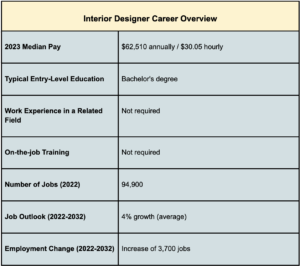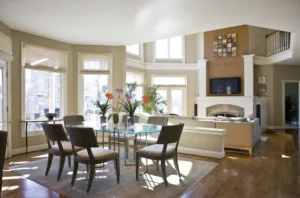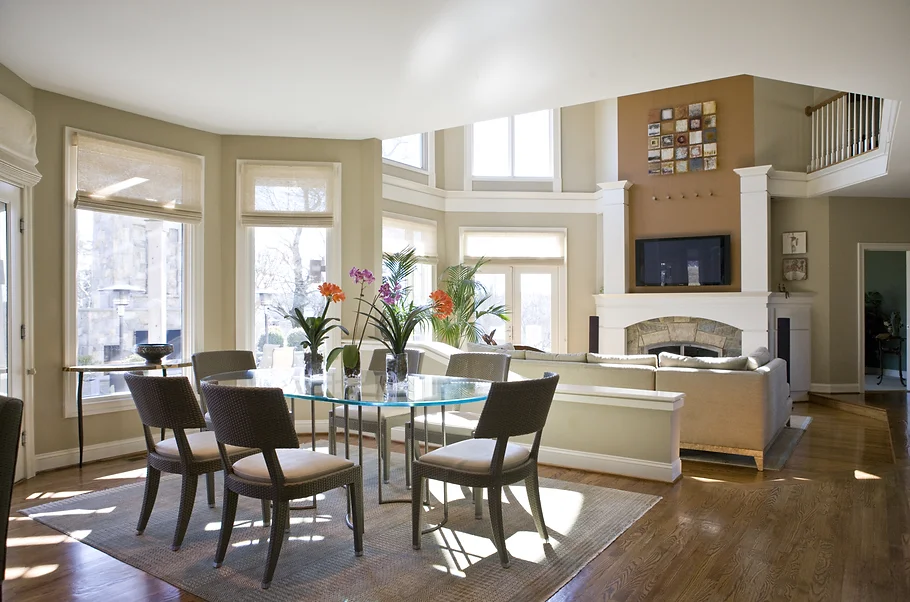Big Picture: Interior Designers
Interior designers are specialized professionals who create functional, safe, and visually appealing indoor spaces. They work with clients to determine needs, select materials, and oversee project execution.
Toni Gocke Wyre, chair of the American Society of Interior Designers (ASID), says “An interior designer is a professional who uses design—through functionality, materiality, safety and building codes, and much more—to support the human experience.”
An interior designer should exhibit a few necessary trade skills:
- They should be experts at seeing a space’s visual and functional possibilities.
- They need highly developed interpersonal skills to clearly understand their client’s needs and secure long-term working relationships with vendors, contractors, and architects.
Danziger Design exemplifies these qualities at the highest level. Our award-winning interior design firm has more than 25 years of experience. For the best Interior Design in the DC Metro Area, Northern VA, and Maryland – Danziger Design.
Key Takeaways
- Creative and technical skills: Designers balance aesthetics with functionality.
- Client collaboration: They work closely with clients to understand and fulfill their vision.
- Space planning: Efficient use of space is paramount.
- Project management: Overseeing the entire design process from concept to completion.
- Material selection: Choosing appropriate materials that meet design and safety criteria.

Statistics from BLS.gov (1)
Core Responsibilities of Interior Designers
Interior designers stay pretty busy during their projects. They manage a range of tasks to bring a project to life.
These tasks include space planning, project management, and material selection.
Below is a detailed table of their core responsibilities:
Core Responsibilities of Interior Designers
| Responsibility | Description | Example |
| Space Planning | Optimizing the layout to enhance functionality and flow. | Designing an open-concept living area. |
| Project Management | Coordinating all aspects of the project, from budgeting to execution. | Managing timelines and contractor schedules. |
| Material Selection | Choosing the right materials for durability and aesthetics. | Selecting sustainable materials for a home. |
| Safety Compliance | Ensuring all designs meet safety codes and regulations. | Implementing fire-resistant materials. |
| Client Consultation | Understanding client needs and preferences to guide design decisions. | Conducting initial client interviews. |
What is the Interior Design Process?
The interior design process begins with an initial consultation, during which designers gather information about the client’s needs, preferences, and budget.
The consultation sets the foundation for the entire project. Designers ask questions, take measurements, and may even create preliminary sketches to understand the space and the client’s vision. This is also when the designer and homeowner build their working relationship.
Home design is a personal and deeply impactful engagement. Designers are literally shaping the lived experiences of people in their homes – there needs to be a bit of a relationship involved to maximize the success of the project (and to earn valuable references).
Following the consultation, designers move to the design development phase. This involves creating detailed plans, selecting materials, and producing 3D renderings or mood boards.
Once the design is approved, the execution phase starts. Designers oversee the implementation, coordinating with contractors, managing timelines, and ensuring the project adheres to the agreed plan.
Finally, a thorough review is conducted to make sure the result meets or exceeds the client’s expectations.
Essential Skills for Interior Designers
Creativity and Vision
Creativity is at the heart of interior design.
Designers must have a strong vision to conceptualize and create spaces that are both beautiful and functional.
They need to think outside the box, using innovative solutions to overcome design challenges and fulfill client desires.
Technical Proficiency
Technical skills are essential for interior designers.
They must understand architectural principles, building codes, and construction methods.
Proficiency in design software, like AutoCAD or SketchUp, allows them to create detailed plans and realistic renderings, ensuring accurate and efficient project execution.
Communication and Collaboration
Effective communication is necessary for interior designers to clearly convey ideas to clients and collaborate seamlessly with contractors, architects, and other stakeholders.
Good communication ensures that everyone involved understands the vision and their role in bringing it to life.
Types of Interior Design Specializations
Interior design encompasses various specializations, each focusing on different aspects of the built environment.
These include residential design, commercial design, and sustainable design.
Below is a comparison of these specializations:
Comparison of Interior Design Specializations
| Specialization | Scope | Skills Required | Typical Projects |
| Residential | Homes and living spaces | Creativity, technical knowledge, empathy | Single-family homes, apartments |
| Commercial | Offices, retail, hospitality, and more | Space planning, project management, branding | Office buildings, restaurants, hotels |
| Sustainable | Eco-friendly and sustainable designs | Knowledge of sustainable materials, energy efficiency | Green buildings, LEED-certified projects |
The Impact of Interior Design on Daily Life
Interior design significantly enhances daily living by improving the look and functionality of spaces.
A well-designed space not only looks good but also boosts mood and productivity. It ensures that every element serves a purpose, making everyday tasks more enjoyable and efficient.
- Increased productivity: Thoughtfully designed workspaces can enhance focus and efficiency.
- Improved comfort: Ergonomic furniture and layout increase comfort.
- Enhanced aesthetics: Beautiful spaces uplift the mood.
- Better organization: Smart storage solutions reduce clutter.
- Overall wellbeing: A harmonious environment promotes mental and physical health.

How to Choose the Right Interior Designer
Selecting the best interior designer for you involves careful evaluation of several factors.
Start by researching potential designers, looking at their portfolios, and reading reviews.
Meet with them to discuss your vision and gauge their understanding and enthusiasm for your project. Trust and communication are key.
- Research potential designers: Look for portfolios and client reviews.
- Evaluate their style: Make sure it aligns with your vision.
- Discuss your project: Communicate your needs and preferences clearly.
- Check credentials: Verify their qualifications and experience.
- Assess communication: Ensure they are responsive and easy to work with.
Unparalleled Interior Design in DC – MD – VA | Dansziger Design
Interior designers facilitate the enhancement of all aspects of a building’s space. Whether for a home or a commercial space, expert designers have the eye to see the client’s vision in its most attractive and functional form.
The impact an interior designer can have on a home or business owner’s life is profound. An effective engagement will improve many aspects of daily life by enhancing a space’s aesthetics and functionality.
Danziger Design is an award-winning and highly celebrated interior design firm serving the greater DC area, including MD and VA. With over 25 years of top-of-the-line interior design, we have everything you need to bring your vision to life.
Want to know more about Danziger Design’s approach to interior design?
Visit our HOMEPAGE for more information, or call today!
Reference:
(1) BLS.GOV, Interior Design, https://www.bls.gov/ooh/arts-and-design/interior-designers.htm#:~:text=type%20of%20building.-,Interior%20designers%20make%20indoor%20spaces%20functional%2C%20safe%2C%20and%20beautiful%20by,%2C%20read%2C%20and%20edit%20blueprints.

